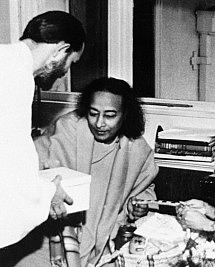
Swami Kriyananda, Paramhansa Yogananda
The 1960s saw much expansion in American society, as well as much upheaval. There were race riots and anti-war demonstrations, and the assassinations of the Kennedy’s and Martin Luther King; there was a significant increase of self-exploration and looking beyond self-imposed limitations.
Young people traveled widely, often living with host families and experiencing new cultures first hand. Many people joined the Peace Corps and spent two years in developing countries, or joined VISTA, a similar program in the U.S.
At the same time, Eastern religion was enjoying a new interest. Yogananda’s classic, Autobiography of a Yogi, became assigned reading in college philosophy courses, which indicates a major shift from traditional higher education.
People were beginning to look both inward through meditation and self study and outward through ways to serve.
The environmental movement gained momentum. More and more people read Thoreau, Whitman and Emerson and began to look to nature for enjoyment and fulfillment.
The idea of working cooperatively began to gain credence and the concept of teamwork and community began to develop.
Boundaries were dissolving as never before; in 1969 Americans landed on the moon.
It was toward the end of this decade that Ananda community began, supported by and reflecting the energy and expansiveness of the time.
In a 1996 interview, Swami Kriyananda stated, “When I was 15, World War II was beginning to get underway. I thought I could envision a time when civilization would be dealt a very serious blow. If we could have a community of people that would preserve the values of civilization, it would be the means by which civilization could build again in the future. I saw a community with engineers, doctors and people of all modern skills, who could bring those skills back.
“Today I think civilization is going to desperately need communities like this, not so much to preserve skills such as engineering, but rather to preserve spiritual values. When you have people scattered, it’s very hard to uphold spiritual values. Seeing one person who is calm, for example, is not going to draw people, but seeing a community of people who are calm, you have to say that it’s what they are doing that makes them that way.”
During Paramhansa Yogananda’s lifetime, he often talked about “World Brotherhood Colonies” and said, “Thousands of youths must go North, South, East, and West to spread these ideas. I am sowing these thoughts in the ether, and my words shall not die!”
As a young disciple of Yogananda, Kriyananda was thrilled and inspired by this idea and vowed to help his guru make these communities a reality. After Yogananda’s passing in 1952, Kriyananda made several fruitless attempts to interest others in his guru’s organization in the idea of World Brotherhood Colonies. However, during this decade Swami Kriyananda saw much upheaval in his own life as well. He was forced to leave the organization, Self-Realization Fellowship, and spent a good deal of time searching for a way to continue serving his guru. (See the book Faith Is My Armor.)
In 1966, he began teaching classes in yoga and meditation at the Cultural Integration Fellowship in San Francisco. He gave several training seminars on Indian culture to Peace Corps volunteers and also had a radio show on two local radio stations. One of his first meditation students was Jyotish (John Novak), who became his secretary and later a teacher of meditation, himself.
